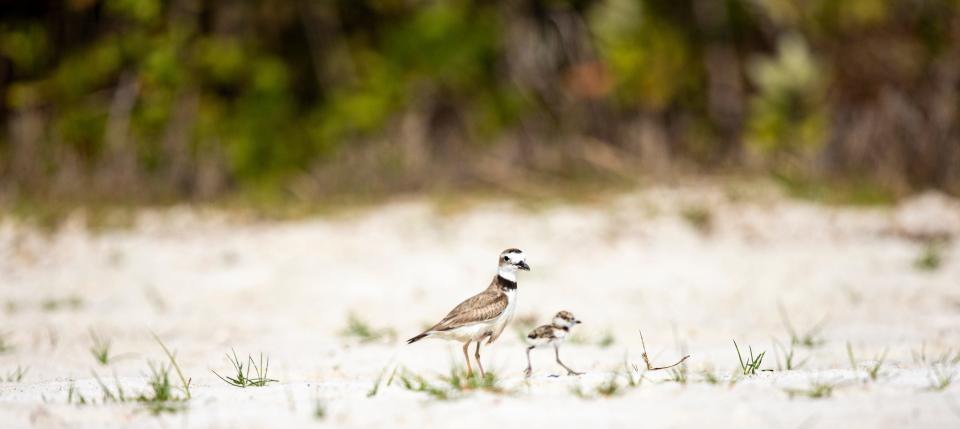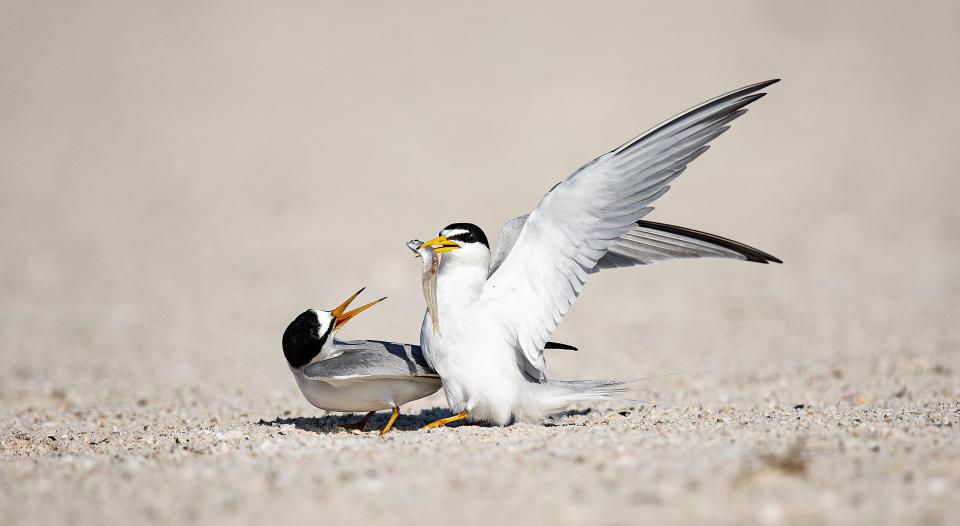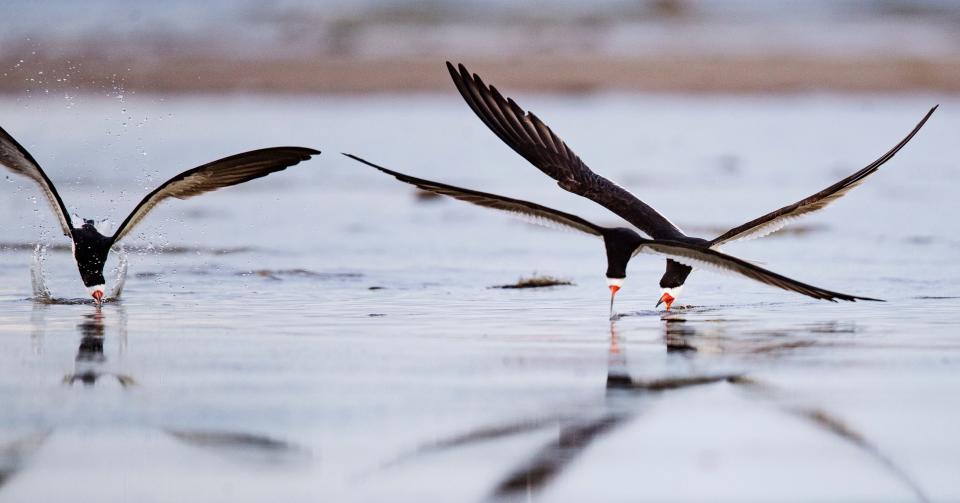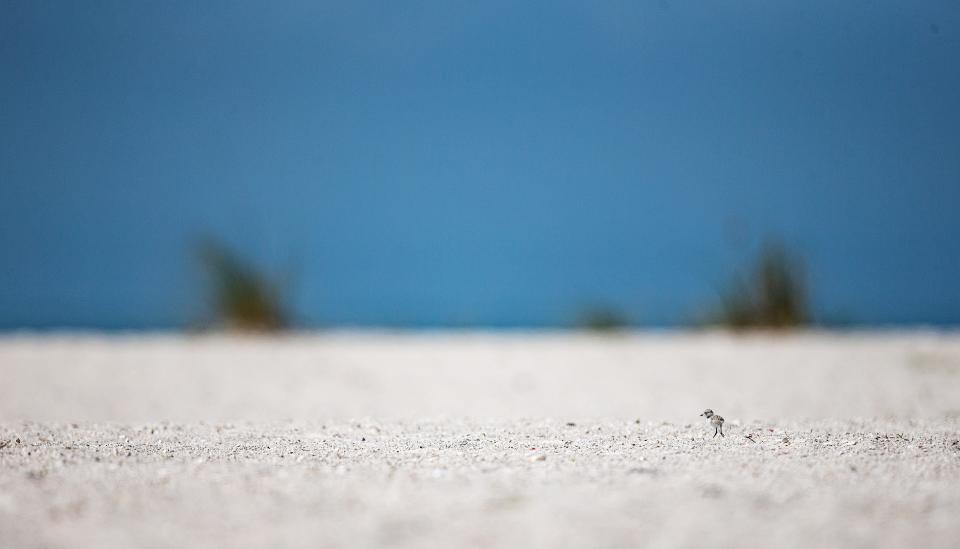Watch out for projectile bird poo: Southwest Florida shorebird nesting season has started
They scratch out tiny nests on some Southwest Florida beaches, lay camouflaged eggs and fight with vigor to defend their territory and their young.
Shorebirds nesting season started a few weeks ago, and hundreds of the tiny birds will be scrambling around undeveloped beaches between now and September.
From the majestic black skimmers to feisty plovers, shorebirds will be feeding and breeding on local beaches for the next five months, working hard to nourish themselves and the next generation.
Their nesting season coincides with some of the busiest beach months of the year, which means human traffic can be high when the adults are trying to feed and rest.
There are five species of shorebird that are prominent in Lee County, while four of the species can be found in Collier.
Lee County is home to black skimmers, least terns, Wilson's plover, snowy plover and the American oystercatcher, which does not regularly occur in Collier.
Berm concern: Groups worry that Fort Myers Beach emergency berm will hurt protected wildlife
Everglades wading birds: Wading bird season produced historic numbers in Everglades
Burrowing owls: 4 things to know about Florida's tiny ground-dwelling birds

"We're just at the beginning of breeding season, so a lot of people will see the signs and string go up," said Rochelle Streker, Southwest Florida shorebird manager for Audubon Florida. "We have seen plover nests, and those guys are already on eggs. They get started nice and early."
Here's a closer look at Southwest Florida shorebirds and how their lives will unfold over the next several months.
These birds are tough
These shorebirds may be small; but ounce for ounce, they're some of the toughest species in the avian world.
"They're going to come for your head, and it's going to be very noisy," Streker said. "Your best bet is just to back away. They will also projectile poo at you, and it stains clothing and is gross and unpleasant."
Streker monitors shorebirds for Audubon in Lee and Collier and said the birds are naturally territorial as their nests and young are very exposed.

"This is an extremely vulnerable moment, and the eggs are hidden in the sand," Streker said. "We're unnatural because we're not predators (but we're relatively large). We're not trying to eat them, we just may step on them."
Streker said the safest place to walk when near shorebird territory is to walk along the low-tide line. No eggs or nests will be below the high tide line as they would get regularly flooded.
"All of our state protected will let you know if you've gotten too close," Streker said. "The divebombing is the least tern and the black skimmers."
Does that bird have a broken wing?
Some shorebirds are known for acting as though they are injured in hopes of luring away potential predators.
They dance around and drag one wing on the ground, as though they are hurt and can't fly.

'They feign an injury," Streker said. "If the bird had actually broke it's wing it wouldn't make that much noise. It's trying to look vulnerable so you as a predator try to eat it instead of the chicks that aren't able to fly away."
Where are these birds?
Shorebirds like undeveloped patch of expansive beach like the area that's found at the south end of Fort Myers Beach.
They're also found at Cayo Costa State Park, on Sanibel Island, at Lovers Key State Park, on the north tip of Bonita Beach and on some Naples beaches as well as Marco Island.
"We're still expecting birds and we've had them at Cayo Cost and Lovers Key and Delnor-Wiggins (State Park)," Streker said. "We have a lot of plovers on Sanibel."
How can the public help?
The Florida Fish and Wildlife Conservation Commission is responsible for protecting listed species and recommends the following when in shorebird nesting territory:
Do the flock walk
Keep at least 300 feet from nesting birds and walk around flocks of birds and stay out of posted areas. Getting too close to nesting shorebirds, seabirds and wading birds can cause them to flush from their breeding sites, leaving vulnerable eggs and chicks exposed to the elements and predators. Egg temperatures can increase to lethal levels after just a few minutes of direct sun exposure. Shorebirds and seabirds nest in shallow scrapes in the sand and their eggs and chicks are well-camouflaged, making them vulnerable to being stepped on unless people look out for them and walk around flocks of birds.

Look for Critical Wildlife Area closures
Be on the lookout for signs designating Critical Wildlife Areas, or CWAs, on the beach or coastal islands — these areas are closed to public access to protect high concentrations of wading birds and shorebirds while they nest and raise their chicks. Boaters and beachgoers can help nesting birds by keeping distance and noise volumes low near CWAs.
Keep Fido at home
Even well-behaved dogs can frighten shorebirds, causing them to abandon their eggs and chicks. If you bring your dog with you to the shore, go to a beach where they’re allowed and follow all leash laws.
Properly stash all trash
Trash and food scraps attract predators, such as raccoons and crows, that prey on shorebird eggs and chicks. Litter on beaches and in the water can entangle birds, turtles and other wildlife. Beachgoers can help beach-nesting birds and other native wildlife by properly disposing of all trash, filling in human-made holes in the sand, and removing all personal gear from the beach before sunset. Fishing line can be deadly to water birds, sea turtles and other wildlife, so be sure to dispose of it properly.
Connect with this reporter: Chad Gillis on Facebook.
This article originally appeared on Fort Myers News-Press: Lee, Collier shorebirds are nesting along coast, expect tiny birds

